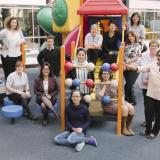Bronchiolitis is a potentially serious chest infection caused by a virus. The virus infects the small breathing tubes (bronchioles) of the lungs, which makes them inflamed. They then produce more mucus than normal, which causes breathing difficulties.
Respiratory syncytial virus (RSV) is usually responsible for bronchiolitis, although other viruses can also cause bronchiolitis. Infections often occur in infants less than 1 year old, usually in winter.
The symptoms of the infection begin like a common cold, with a runny nose, cough and fever. The coughing may become worse over the next day or 2, and rapid breathing and wheezing can make feeding young children difficult. Babies under 1 year old who have bronchiolitis will often wheeze when breathing out. Wheezing can last for a few days, but the cough can last for weeks.
How it spreads
Bronchiolitis spreads by droplets in the air that contain the virus or direct contact with mucus or saliva. People get infected by:
- breathing in droplets when an infected person breathes, coughs or sneezes on them
- touching a surface contaminated with droplets – for example, hands, tissues, toys or eating utensils – and then touching their eyes, nose or mouth.
Exclusion period
If a person has respiratory symptoms (cough, sneezing, runny or blocked nose, sore throat), exclude them only if:
- the respiratory symptoms are severe or
- the respiratory symptoms are getting worse (more frequent or severe), or
- they also have concerning symptoms (fever, rash, tiredness, pain, poor feeding).
Otherwise do not exclude.
A person often has an ongoing cough after they have recovered from a respiratory infection. If their other symptoms have gone and they feel well, they can return to the service.
Actions for educators and other staff
Ensure staff and children have good hand and respiratory hygiene.
Ensure staff use appropriate cleaning practices, as described in the Staying healthy guideline.
Actions for parents and carers
Take your child to a doctor if they develop rapid breathing or wheezing.
Keep your child at home until their symptoms have gone and they feel well. If your child still has a cough, but their other symptoms have gone and they feel well, they can return to the service.
Teach them to cough or sneeze into a tissue, then throw the tissue into a bin and wash their hands. If there are no tissues nearby, teach them to cough or sneeze into their inner elbow instead of their hands.
Avoid contact between your child and other children, or frail and elderly people, until the child is feeling well.
More information about bronchiolitis
See healthdirect for more information on prevention, diagnosis and treatment of bronchiolitis.
To find out if a child needs medical help, you can:
- use the health direct online symptom checker
- speak to a registered nurse by calling their 24-hour health advice hotline on 1800 022 222.


